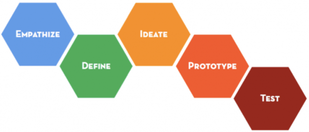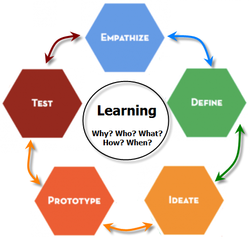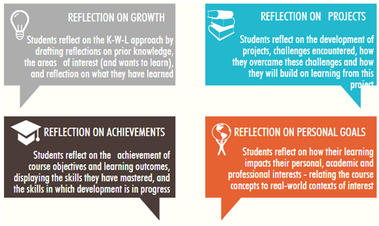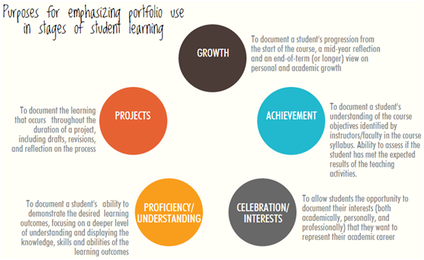Finding a common ground to learning |

“Learning is a treasure that will follow its owner everywhere”
- Chinese Proverb
When I began the journey towards the Masters of Arts in Educational Technology (MAET) degree in the Fall quarter of 2012, I revisited the feelings of a blurry-eyed freshman stepping on to campus for my first day of undergraduate studies. I was full of excitement for what lay ahead in my future studies, but also unsure of myself as a first-time distance learner in an online education setting. I had recently started in a course scheduling position at Stanford University, and was seeking ways to integrate my graduate studies into daily scheduling operations. I had hoped to interweave course content and class projects into my profession, but was more concerned about developing as a learner to help strengthen my career down the road.
As I reflect back now three years later, my blurry-eyed vision of the unknown has become a LASIK-treated eye for the purpose of student learning and technology integration, ready for the next chapter of learning beyond a master’s degree. The MAET program not only provided an authentic learning experience directed by my academic interests, but also provided clarity on the fundamental concepts of student learning and instructional design. Since the start of the MAET degree I have moved on to two new positions at Stanford, and moved into a management position within the Office of the University Registrar. I can only imagine that my escalation was partially due to my pursuit of a graduate degree and the willingness to integrate concepts learned in the master’s program into my day-to-day operations. For that I am thankful; the MAET degree has pushed me professionally to try new approaches in a professional setting. More importantly the MAET program gave me clarity to see that our learning is a cyclical process that continues to evolve. Learning is never complete, unless the learner makes the decision to stop learning. We are such a fortunate species that we can continue to grow, to learn, and to build on previous knowledge/experiences to further understand the “whys” and “hows” of learning. Learning is not about getting from point A to B, receiving a course grade and moving to the next subject. Rather, learning is about the journey, from start to finish, and then reflecting on what you have learned to build on previous experiences. It is at this point, when we can link previous learning experiences to help advance understanding, that the learning experience is truly rich.
As highlighted in my Future Goals essay, I am an advocate for further defining the learning experience through reflection and portfolio design, to capture what the student learned (in a course) and to set the foundation for future learning. When I began the program in 2012, one goal was to achieve an ‘A’ (4.0) in each of the ten courses required for the degree. I was so focused on the end result and the traditional student view of a grade defining mastery of a subject that I failed to acknowledge the potential wealth of information I would collect from each course on this journey. My main concern originally was essentially the output of my labor through grades listed on the final transcript. As those three and a half years now near the end, I view my original goal as a narrow minded vision for the purpose of a graduate degree. However, as I attempt to define this brilliant journey, I have learned two fundamental concepts that I will carry with me throughout my career that I would not have experienced, if it were not for the MAET program:
These two common themes that were exhibited across multiple courses within the MAET program can be applied to both student learning methods and to the development of instructional design, as highlighted below.
- Chinese Proverb
When I began the journey towards the Masters of Arts in Educational Technology (MAET) degree in the Fall quarter of 2012, I revisited the feelings of a blurry-eyed freshman stepping on to campus for my first day of undergraduate studies. I was full of excitement for what lay ahead in my future studies, but also unsure of myself as a first-time distance learner in an online education setting. I had recently started in a course scheduling position at Stanford University, and was seeking ways to integrate my graduate studies into daily scheduling operations. I had hoped to interweave course content and class projects into my profession, but was more concerned about developing as a learner to help strengthen my career down the road.
As I reflect back now three years later, my blurry-eyed vision of the unknown has become a LASIK-treated eye for the purpose of student learning and technology integration, ready for the next chapter of learning beyond a master’s degree. The MAET program not only provided an authentic learning experience directed by my academic interests, but also provided clarity on the fundamental concepts of student learning and instructional design. Since the start of the MAET degree I have moved on to two new positions at Stanford, and moved into a management position within the Office of the University Registrar. I can only imagine that my escalation was partially due to my pursuit of a graduate degree and the willingness to integrate concepts learned in the master’s program into my day-to-day operations. For that I am thankful; the MAET degree has pushed me professionally to try new approaches in a professional setting. More importantly the MAET program gave me clarity to see that our learning is a cyclical process that continues to evolve. Learning is never complete, unless the learner makes the decision to stop learning. We are such a fortunate species that we can continue to grow, to learn, and to build on previous knowledge/experiences to further understand the “whys” and “hows” of learning. Learning is not about getting from point A to B, receiving a course grade and moving to the next subject. Rather, learning is about the journey, from start to finish, and then reflecting on what you have learned to build on previous experiences. It is at this point, when we can link previous learning experiences to help advance understanding, that the learning experience is truly rich.
As highlighted in my Future Goals essay, I am an advocate for further defining the learning experience through reflection and portfolio design, to capture what the student learned (in a course) and to set the foundation for future learning. When I began the program in 2012, one goal was to achieve an ‘A’ (4.0) in each of the ten courses required for the degree. I was so focused on the end result and the traditional student view of a grade defining mastery of a subject that I failed to acknowledge the potential wealth of information I would collect from each course on this journey. My main concern originally was essentially the output of my labor through grades listed on the final transcript. As those three and a half years now near the end, I view my original goal as a narrow minded vision for the purpose of a graduate degree. However, as I attempt to define this brilliant journey, I have learned two fundamental concepts that I will carry with me throughout my career that I would not have experienced, if it were not for the MAET program:
- Focus first on the needs of your target audience (students, users, learners), not the possibilities of the product or technology
- Formative assessment provides opportunities for additional learning while actively engaging both students and instructors
These two common themes that were exhibited across multiple courses within the MAET program can be applied to both student learning methods and to the development of instructional design, as highlighted below.
Focus first on the needs of your target audience (students, users, learners)

As marketing campaigns promote the latest glitz and glamour from emerging technologies, we as consumers are driven to take the latest gamble on the newest gadget. However, when it comes to an educational setting, we must step back from this mindset to assess the learning environment first, and place the needs of our learners at the forefront of the technology discussion. Through a detailed analysis of the TPACK relationships (technology, pedagogy, and content knowledge) in CEP 800 (Learning in School and Other Settings), the course’s progression helped me understand the purpose of technology integration in educational settings and ‘how’ to utilize the technology to enhance the student learning experience. The course forced me to raise questions about technology integration as a valuable investment to the learning experience and to analyze the benefits of such integration. I also learned that the evaluation of future technologies should be based on existing goals of assessing student learning, rather than trying to add new goals to support the technology. Even though I am not an instructor, in my current management role I can use these concepts to determine the purpose of technology integration and subsequently which products to introduce to assist our students in monitoring degree progress or assisting staff in assessing student performance. The fundamental concepts of understanding the users’ needs and purpose of promoting the learning goals across all careers holds true as we determine if the technology integration benefits the learning experience.
Similarly, the same fundamental concepts can be found in designing learning technologies. In CEP 817 (Learning Technology through Design), the course focused on the Stanford Design Model as the foundation for developing learning technologies to meet the original needs of the product user group(s). In proceeding through the design model to reach a testable product, the process began with identifying the main issue and then empathizing with the users/target audience for whom the issue impacts.
Similarly, the same fundamental concepts can be found in designing learning technologies. In CEP 817 (Learning Technology through Design), the course focused on the Stanford Design Model as the foundation for developing learning technologies to meet the original needs of the product user group(s). In proceeding through the design model to reach a testable product, the process began with identifying the main issue and then empathizing with the users/target audience for whom the issue impacts.
My enrollment in this course aligned with a transition to a management position with the Degree Progress division of the Office of the University Registrar. As I found myself in a management role for the first time, I came into the course with fresh eyes and a collection of data entry issues that were impacting division performance. The recognition of these issues provided a valuable team-building activity as I sat down with my new staff to discuss these errors and understand their concerns as to why the data entry errors were occurring. Through a ‘5 Whys’ assessment I was able to understand their frustrations of inadequate documentation/training for new temporary employees (who oversee a majority of our data entry/form processing). I was able to use CEP 817 as a guide to build a connection with my team, while also moving towards a prototype design to resolve our ongoing data entry issues. With my team’s help and the course’s progression, I worked through the Stanford Design Model to integrate each design stage into my daily setting, with the end result being a digital documentation portal created through the Confluence web application.
Formative assessment use to promote additional learning

While student learning and instructional design centers on the needs of your learners/users, learning and design are also iterative processes that benefit through the integration of formative assessment. Through the progression of the Stanford Design Model in CEP 817, each stage allowed me as a designer to reflect on the product’s progress and assess the design towards the original needs outlined in the empathy stage. It was also in this course that I first became comfortable with the possibility of failure as a stepping stone to future successes. Thanks to the iterative nature of the design model, allowing designers to loop back to previous stages to enhance future outputs, my fear of failure regressed and I became more motivated to develop a documentation portal prototype that my team could continue to develop. We may fail, fail often or fail ugly in the development of design, but that doesn’t mean our whole design has failed as discoveries can follow successes as well as failures. Thankfully due to the nature of the design model, I learned that we can re-evaluate a project and even step back to the define phase and adjust our point of view if need be. As a result of integrating the Stanford Design Model into my daily operations at Stanford, I was able to ‘learn by doing’, essentially jumping into developing my design and learning from the design process. At the conclusion of the course, and as I continued to develop the Confluence pages, I felt motivated to adjust the Stanford Design to reflect my learning and my view of the design process as a model of formative assessment, as detailed to the right.

As I expanded my thinking on formative assessment beyond the design model and into student learning in general, CEP 813 (Electronic Portfolios and Assessment) introduced the Universal Design for Learning Guidelines (UDL) and addressed the value of ongoing assessment during instruction to determine student learning and to assess an instructor’s pedagogical practices. In addition, it was through this course that I recognized formative assessment was both a product-based and a process-driven mechanism that measures ‘what’ the student learned and the process of ‘how’ the student learned. By integrating formative assessment practices into curriculum/lesson plan designs, the methods used actively involve learners in the learning process and helps inform learners of their level of understanding. It was through this detailed study on assessment in CEP 813 that I learned that formative assessment can motivate and inspire students when they can see their progress on a constant basis. Rather than solely using an exam or essay to assess mastery of a subject, the implementation of student reflection allows students to bridge learning by connecting prior knowledge to current class concepts. Reflections also allow for valuable self-recognition of growth through the achievements in class projects, skills mastered during project development and the ability to overcome adversity with tackling project challenges/hurdles. In linking these concepts to my own practice, I developed an online course reflection prototype in the Canvas learning management system to mimic the potential student reflections as a complement to the current online course evaluations (OCE) that take place at the end of semester/quarter/course. As Stanford undergoes a re-design to the OCE setup/process this Autumn quarter, reflection will be an item for consideration in the proposed modifications to the system.

One of the early courses in my academic career, ED 800 (Concepts of Educational Inquiry) introduced the concept of self-reflection as a valuable tool for instructors to reflect on their own thinking with an assessment of one’s own understanding. Previously, I had acknowledged the use of course reflections as a method of formative assessment to evaluate student understanding on a particular subject or lesson plan. Other in-class tools such as clickers or websites like PollEverywhere were visible methods to instantly assess student understanding in real time. However, thanks to the brilliance of Vivian Paley (as found in The Girl With the Brown Crayon), I was able to fully appreciate the importance of assessing your own learning and cognitive recognition through reflection. Paley turned to her daily journal to reflect on the items the students addressed in class and her reaction (or lack thereof) to these exchanges. It was through this understanding that I took a similar, albeit less frequent approach, to our 25Live training sessions that coincided with my enrollment in ED 800. 25Live is a scheduling tool that was released campus wide in the summer of 2013, for which myself and a colleague were responsible for a majority of the training sessions. After each class I would discuss the session with my colleague and then take notes on areas for growth and items that went well, while also reflecting on the questions asked. My goal was to improve the training sessions through content modifications (based on the learners’ suggestions) and improved teaching methods (as identified in self-reflection after these classes). While our training sessions were not as common of an occurrence as Paley’s everyday kindergarten class, the reflection exercise gave me a sense of accomplishment while also acknowledging my errors and misunderstandings from instruction. Through Paley’s suggestive guidance I learned that self-reflection as an instructor is a powerful tool for better understanding your audience and self.
As my academic career at Michigan State winds down, my enrollment and subsequent development in CEP 807 (Proseminar in Educational Technology) has provided me with a visual representation of my learning during my master’s career while also assessing my journey by acting as the University’s comprehensive exam requirement. The course structure allowed me to revisit my learning over the last three and a half years by compiling my digital creations into one central location, an electronic portfolio. The course expanded on the concepts covered in CEP 813 by combining the product (my collection of digital artifacts) and the process (self-reflective essays on achieving learning goals, preparation for future learning and a synthesis of the master’s program) into one central project to exhibit my learning. While the portfolio is a summation of my work, the design process over the course of the semester combined with the feedback from classmates and instructors, has provided the opportunity to revisit and revise my portfolio content. Not only was I able to assess my own learning through my academic career, but the iterative process during the semester allowed me to strengthen my portfolio to accurately represent my learning in this course and others in the MAET program. The creation of my portfolio has made me realize what an amazing journey the last three and half years have been, while also setting a strong foundation for my future learning.
As my academic career at Michigan State winds down, my enrollment and subsequent development in CEP 807 (Proseminar in Educational Technology) has provided me with a visual representation of my learning during my master’s career while also assessing my journey by acting as the University’s comprehensive exam requirement. The course structure allowed me to revisit my learning over the last three and a half years by compiling my digital creations into one central location, an electronic portfolio. The course expanded on the concepts covered in CEP 813 by combining the product (my collection of digital artifacts) and the process (self-reflective essays on achieving learning goals, preparation for future learning and a synthesis of the master’s program) into one central project to exhibit my learning. While the portfolio is a summation of my work, the design process over the course of the semester combined with the feedback from classmates and instructors, has provided the opportunity to revisit and revise my portfolio content. Not only was I able to assess my own learning through my academic career, but the iterative process during the semester allowed me to strengthen my portfolio to accurately represent my learning in this course and others in the MAET program. The creation of my portfolio has made me realize what an amazing journey the last three and half years have been, while also setting a strong foundation for my future learning.
When I look back on my academic career at Michigan State, I see a path traveled in which hours were spent writing, reading and creating, all based on my interest to learn the “whys” and “hows” of educational technology and instructional design development and integration. The MAET program provided valuable themes/theories to use across all spectrums in assessing the value of technology integration and the purpose of design. I chose this degree to better understand the purpose of instructional design and understand how to adapt to the emerging educational technologies evident in today’s society. Through the program, I was able to design my own path in the master’s program, with the help of professors and classmates as guides to navigate my learning. For the learning experiences with classmates and professors and the wealth of information learned through course content, I thank Michigan State University for the learning opportunity and for setting a foundation for future learning as my career continues to develop.
All photos belong to Matt Shaw or the public domain, unless otherwise noted.